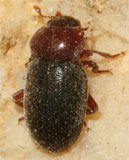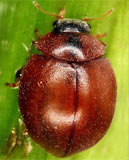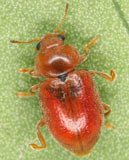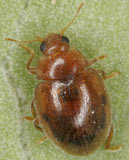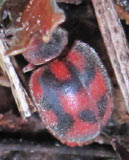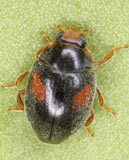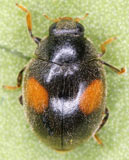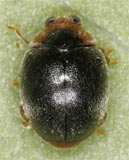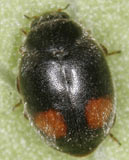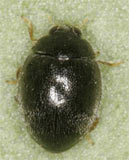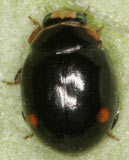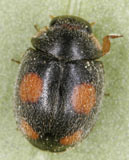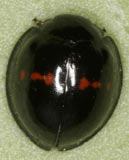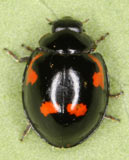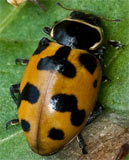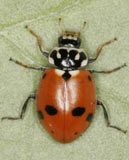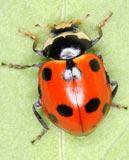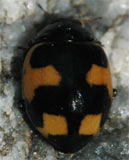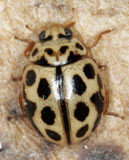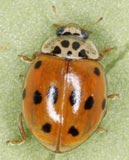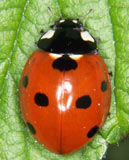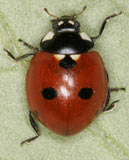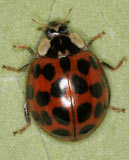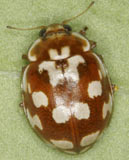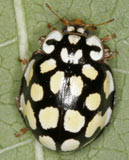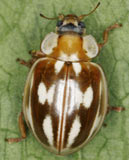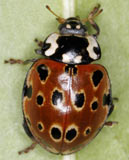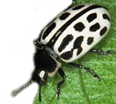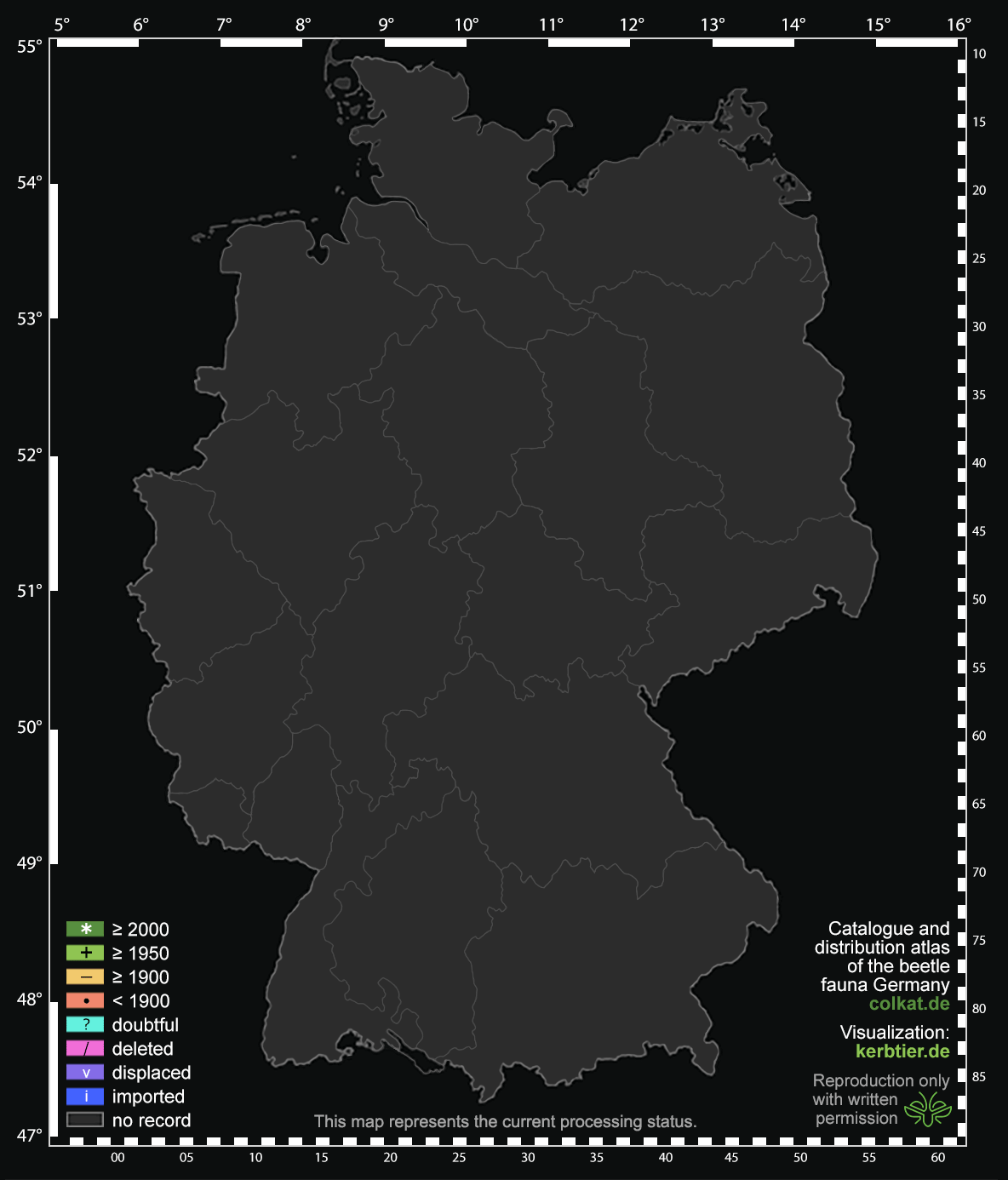The ladybirds (Coccinellidae) of Germany |
© Klaas Reißmann and Christoph Benisch, 2013 |
1. Introduction |
|
The ladybirds (family Coccinellidae) are most probably the best known family of the beetles at all. Who does not know them, the ubiquitous seven-spot ladybird Coccinella septempunctata or the two-spot ladybird Adalia bipunctata? Every child knows the myth that the age of a ladybird corresponds with the number of spots on the elytra, and even some grown-ups take it for granted. It is generally well known, that ladybirds are useful animals, because they devour a large number of aphids during their life span. But only few people know that many ladybirds do not only prey on aphids, but also feed on mealybugs, scale insects, jumping plant lice or spider mites. Some species feed on mildew or pollen. A few species are not predaceous but phytophagous, they feed on various plants (Angiospermes) or are even regarded as pests. |
2. Morphology |
|
The body length of the ladybirds varies between approx. 1 mm in the smallest species and roughly more than 10 mm in the largest known species. The body of most ladybirds is of short oval shape with a more or less convex surface, which makes them look rather rounded. Only the representatives of the subfamily Lithophilinae and the species of the tribes Coccidulini (Coccinellinae) and Novini (Coccinellinae) are distinguished by a markedly oblong and at the same time flattened habitus.  Fig. 1: Curvature of the body shape: (a) flattened in Hippodamia tredecimpunctata; (b) convex in Sospita vigintiguttata; (c) domed in Chilocorus bipustulatus
Fig. 1: Curvature of the body shape: (a) flattened in Hippodamia tredecimpunctata; (b) convex in Sospita vigintiguttata; (c) domed in Chilocorus bipustulatusThe antennae are mostly elongate and eleven-membered with a marked, closed club at the end. Contrary, the species of tribe Chilocorini exhibit short, eight- to nine-membered antennae, but the club is well marked too.  Fig. 2: (a) without pubescence, Halyzia sedecimguttata; (b) with pubescence, Platynaspis luteorubra
Fig. 2: (a) without pubescence, Halyzia sedecimguttata; (b) with pubescence, Platynaspis luteorubra
The apical member of the maxillary palps is typically ace-shaped. There are species without noticeable pubescence (especially the well-known species from subfamily Coccinellinae, e.g.
Coccinella septempunctata or Adalia bipunctata), but also species with a very dense pubescence of the upper body surface (e.g. genus
Scymnus, Rhyzobius and others). The legs are of normal shape and the tarsi are four-membered. The second member of the tarsus is lobate, the third is very small and inconspicuous in most cases
and is more or less "hidden" between the lobes of the second. In a superficial examination the tarsi appear to be three-membered (hence the tarsi are also described as "pseudo-trimeric" or
"cryptotetrameric"). |
3. Coloration |
|
The variability of the ladybirds is immense. The primary base colors are yellow, red, black and brown. Not only the pattern, but also the coloration itself can vary considerably in a species,
causing beetles of the same species to look so different, that a layperson might believe in two distinct species. For example, more than 150 aberrations have been described of the two-spot
ladybird (Adalia bipunctata). Although they are scientifically meaningless, they still give an impression of the tremendous variability of this species regarding both color and pattern.
Other species like the ten-spotted ladybird (Adalia decempunctata) and the Harlequin ladybird (Harmonia axyridis) don't fall short of the two-spot ladybird in any way regarding
their variability. 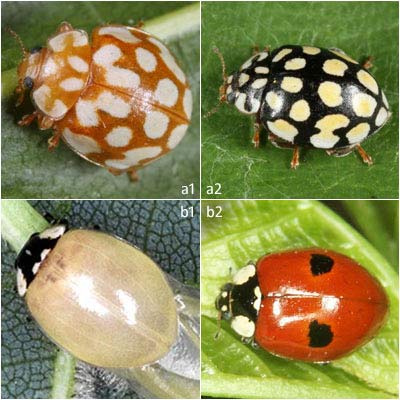 Fig. 4: Color development in ladybirds: (a) Sospita vigintiguttata; (b) Adalia bipunctata; 1=immature, 2=fully colored; Photos © Ingrid Altmann, use with written permission.
Fig. 4: Color development in ladybirds: (a) Sospita vigintiguttata; (b) Adalia bipunctata; 1=immature, 2=fully colored; Photos © Ingrid Altmann, use with written permission.
In some species however, among them the seven-spot ladybird (Coccinella septempunctata) the coloration is relatively constant which makes them easier to determine. Despite the same pattern,
the size of the spots can still vary considerably (in the seven-spot ladybird especially in the east of its distribution range), which makes the differentiation from the very similar
Coccinella magnifica more delicate. |
4. Distribution |
|
The family of the ladybirds comprises approx. 6000 species worldwide, thereof 82 are (or were) recorded from Germany.
Ladybirds are present in nearly all parts and habitats of the world with exception of regions of eternal ice and water. Apart from the latter two ladybirds are present in all habitats where
plants provide the livelihood for aphids, scale insects and other prey. The range of many domestic species in Germany reaches for beyond the German borders into the North and South, as well as
to the East.  Fig. 6: Number of ladybird species imported to Europe in the years 1875 to 2008 by origin (after H. Roy, A. Migeon, BioRisk 4(1): 293–313 (2010))
Fig. 6: Number of ladybird species imported to Europe in the years 1875 to 2008 by origin (after H. Roy, A. Migeon, BioRisk 4(1): 293–313 (2010))
Even more extreme is the occurrence of Scymnus subvillosus in Germany, which has been recorded from very few warm locations – entirely isolated from the its normal range: The species is known
from a few locations in Baden, Palatinate, Rhineland, Brandenburg and Saxony, whereas the nearest occurrences are located in the far southeast of Europe, in South Slovakia.
Such cases are referred to as extinction zone within the distribution range of a species.
Other species can only survive above a certain elevation in the mountains, e.g. Hippodamia alpina which is limited in Germany to the Alps and the alpine range of the Black Forest in Baden-Württemberg.
In some cases the habitat is the limiting factor: Brumus oblongus and Oenopia impustulata are only present in moors and bogs. These species are called "boreal"; they can only exist
in these locations due to the local cool climate of these habitats. Many German species however are present throughout the country. Their presence is normally only limited by the availability
of their food resources (aphids etc.), which are ubiquitous in most cases.
Fig. 7: Number of ladybird species imported to Europe in the years 1875 to 2008 by target country (simplified after H. Roy, A. Migeon, BioRisk 4(1): 293–313 (2010); vector map by Simon Eugster).
Occasionally alien species are recorded which are not part of the Germany or even European fauna at all. These beetles have been either introduced with transports or have been actively
imported as a biocontrol agent against pests in greenhouse horticulture. One of these examples is the Australian mealybug ladybird Cryptolaemus montrouzieri, which is used as a biocontrol
agent against mealybugs in greenhouses and tropical displays in botanic gardens. As this species is very sensitive towards cold temperatures, escapees cannot survive even the mildest
winters in Central Europe and consequently cannot establish populations in the wild. |
5. Hibernation |
 Fig. 8: Harmonia axyridis landing and preparing for hibernation in Bammental, Germany. Photos © Jutta Bastian, use with written permission.
Fig. 8: Harmonia axyridis landing and preparing for hibernation in Bammental, Germany. Photos © Jutta Bastian, use with written permission.
Hibernation is a fascinating aspect in the life of the ladybirds. Some species tend to aggregate for hibernation. All species displaying this type of behaviour
have two things in common: They feed on prey animals (mainly aphids) with a limited period of occurrence, and they have long dormancy periods. Aggregators select rather different locations
for hibernation aggregation, and two basic schemes are distinguished: On the one hand the so called hypsotactic, on the other hand climatotactic aggregators. |
6. Development |
 Fig. 9: Development stages of Calvia quatuordecimguttata: (a) adults mating; (b) oviposition; (c) egg clutch; (d) freshly hatched larvae; (e) larva; (f) pupa. Photos © Ingrid Altmann,
use with written permission.
Fig. 9: Development stages of Calvia quatuordecimguttata: (a) adults mating; (b) oviposition; (c) egg clutch; (d) freshly hatched larvae; (e) larva; (f) pupa. Photos © Ingrid Altmann,
use with written permission.
Normally ladybirds mate shortly after the dormancy period. Although mostly several copulations take place, one is typically enough to fertilize a female permanently. The semen is stored
in the so called receptaculum seminis, where it stays useable for the entire lifespan of the female. The number of eggs per deposition varies considerably in the European species.
It has been elucidated for around one third of the domestic species and ranges between 2 in Stethorus punctillum and 51 eggs in Coccinella septempunctata.
The duration of the egg development largely depends from temperature. Under outdoor conditions it takes five to ten days.Towards the end of the egg development the unhatched larva
can be seen through the transparent egg menbrane. The larvae of most species have so called egg teeth on the upper side of the prothorax and the head to break to egg membrane open.
The entire hatching process can take around one hour or more. The egg teeth are lost after the first molt – first instar larvae are therefore easily recognizeable by the
presence of egg teeth. |
7. Parasites |
|
Like many other animals ladybirds are attacked by a number of predators, parasites and parasitoids. Despite the fact that the eggs of many other insect species are parasitized by hymenopterans of various families (z.B. Mymaridae and Encyrtidae), and despite tremendous research efforts this kind of egg parasitism could not be observed in any carnivorous European ladybird species. In principle, the eggs a large enough in at least in some phythophagous ladybirds eggs are regularly parasitized. One reason for the missing of egg parasites could be the fact that parasites normally slow down the development and hatching of the host. As carnivorous ladybird larvae feed on the remaining eggs and egg shells this would be a risk for the parasite. However, there might be different reasons for the absence of egg parasites.
Contrary to the eggs, larvae are regularly parasitized. Hymenopterans of genus Homalotylus are known parasites. Also hyperparasitism has been observed: Occasionally the Homalotylus larva is parasitized itself
by other hymenopterans. Further known parasites of ladybird larvae are the hymenopterans Pachyneuron muscarum (probably as hyperparasite),
Oomyzus sempronius and Tetrastichus epilachnae. Normally, an infestation is not easily visible, as the parasites attack the vital organs at a late stage in the development thus killing the host.  Fig. 11: The parasite Dinocampus coccinellae: (a) Female of D. coccinellae stalks Hippodamia tredecimpunctata; (b) Cocoon of D. coccinellae under Coccinella septempunctata. Photos © Lynette Schimming,
use with written permission.
Fig. 11: The parasite Dinocampus coccinellae: (a) Female of D. coccinellae stalks Hippodamia tredecimpunctata; (b) Cocoon of D. coccinellae under Coccinella septempunctata. Photos © Lynette Schimming,
use with written permission. Fig. 12: The tachinid Medina separata. Photo © Patrick Derennes, use with written permission.
Fig. 12: The tachinid Medina separata. Photo © Patrick Derennes, use with written permission.
The tachinid fly Medina separata (Diptera, family Tachinidae) has developed a special method of infesting it host. It perches itself on the back of the beetle. If the perturbed beetle opens its elytra slightly
Medina separata uses this short moment to place an egg underneath the elytra. The larva hatching from the egg burrows its way through the intersegmental membrane into the abdomen of the ladybird.
The second larval instar hibernates within the beetle and concludes its development cycle only in the spring of the following year once the beetle has started to feed.
The developed larva leaves the host and pupates in the ground. The females of Medina separata seem to attack only female ladybirds. It is unclear, if and what kind of advantage this behaviour
brings for the larva. 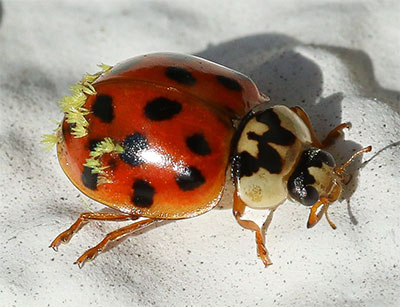 Fig. 13: Harmonia axyridis infected by a obligate insect ectoparasitic fungus (Laboulbeniales). Photo © Juliane Ahlers, use with written permission.
Fig. 13: Harmonia axyridis infected by a obligate insect ectoparasitic fungus (Laboulbeniales). Photo © Juliane Ahlers, use with written permission.
There is also a number of predators which hunt ladybirds. Besides spiders (Araneae) also ground beetles (family Carabidae) attack ladybirds, also hoverfly larvae (family Syrphidae), green lacewing larvae
(Chrysopidae) and shield bugs (Pentatomidae) prey on ladybirds. Despite the warning coloration (aposematism) and the so called "Reflex bleeding" (beetles exude alkaloid-containing lymph through the joints
of the exoskeleton) there is a number of vertebrates that prey on ladybirds. Eurasian Tree Sparrows (Passer montanus) collect large numbers of coccinellids to feed their squabs.
Further predators include shrews, lizards and frogs as revealed by examinations of stomach contents. Ladybirds also tend to cannibalism, which is an additional threat to the eggs and larvae. |
8. Fact sheets |
|
1. Lithophilus connatus (PANZ., 1796)
Stenotopic - xerothermophilous - myrmecophilous - entomophagous
2.6 - 3.6 mm. Pontic-Pannonian and Mediterranean species. So far only old records from the 19th Century from Bavaria, the species is regarded as missing or extinct in Germany.
Lives in steppe heath, calcareous grassland and warm slopes. Under stones, often near ants of the genera Plagiolepis, Tetramorium and Messor. Feeds on insects, occasionally on carrion.
2. Henosepilachna argus (FOURCR., 1762)
Stenotopic - thermophilous - herbicolous - phytophagous
6.0 - 8.0 mm. In South Europe, southern Central Europe, North Africa and Asia Minor. Lives in sunny and warm locations, like edges of forests, dry slopes, oligophagous
on plants of the gourd family (Cucurbitaceae), especially on red bryony Bryonia dioica.
3. Henosepilachna elaterii (ROSSI, 1794)
Stenotopic - thermophilous - herbicolous - phytophagous
7.0 - 10.0 mm. Southpalearctic species, in Europe of Mediterranean distribution, can reach southern Central Europe. Has been recorded several times for Germany by mistake.
In all cases it was confused with its sister species H. argus. Phyllophagous on plants of the gourd family, like pumpkin, cucumber and melon.
4. Subcoccinella vigintiquatuorpunctata (L., 1758)
Eurytopic - xerophilous - herbicolous - phytophagous
3.0 - 4.0 mm. Palearctic species, Europe, North Africa, West Asia, Russia till Siberia. Lives and feeds on Silene, Lychnis, Dianthus, Medicago, Trifolium and further species.
Can become a pest on various cultivated plants. Prefers dry meadows, ruderal site, dry slopes and fallow vineyards.
6. Coccidula scutellata (HBST., 1783)
Stenotopic - paludicolous - herbicolous - aphidophagous
2.5 - 3.0 mm. Palearctic species, Europe, Asia, Siberia. On marsh and water plants, mainly common reed (Phragmites) and bulrush (Typha), where it preys on various aphids.
7. Coccidula rufa (HBST., 1783)
Eurytopic - herbicolous/phytodetriticolous - aphidophagous
2.5 - 3.0 mm. Palearctic species, Europe, Asia, Siberia. On marsh and water plants, mainly common reed (Phragmites) and bulrush (Typha), where it preys on various aphids,
including the Mealy plum aphid Hyalopterus pruni.
8. Rhyzobius litura (F., 1787)
Eurytopic - xerophilous - herbicolous - aphidophagous
2.5 - 3.0 mm. South and Central Europe, North Africa, Asia Minor. Lives in warm habitats, sunny slopes, heathland and fallow vineyards, where it preys on various aphids.
This species is considerably rarer than the following.
9. Rhyzobius chrysomeloides (HBST., 1792)
Eurytopic - herbicolous, arboricolous/phytodetriticolous - aphidophagous
2.5 - 3.5 mm. South and Central Europe, North Africa. Practically ubiquitous, especially on pine (Pinus), where it preys on various aphids. When disturbed, the beetle feigns death (thanatosis).
The black color pattern of the elytra is very variable, making it more difficult to distinguish from the previous species.
10. Novius cruentatus (MULS., 1846)
Stenotopic - silvicolous - arboricolous - coccidophagous
2.5 - 4.0 mm. South Europe and Mediterranean region, North Africa, Syria, Asia Minor. In Germany only isolated occurrences in the northern and eastern part.
Mainly on pine (Pinus) and the immediate surroundings, where it preys on the pine monophlebid Palaeococcus fuscipennis and other scale insects.
11. Scymnus apetzi MULS., 1846
Stenotopic - thermophilous - herbicolous - aphidophagous
2.0 - 3.0 mm. Southpalearctic species, South and Central Europe, North Africa, Asia Minor, South Siberia. Lives on dry and warm slopes, fallow vineyards and heathland.
Preys on aphids on thistle species (Carduus, Cirsium).
12. Scymnus marginalis (ROSSI, 1794)
Stenotopic - xerothermophilous
2.1 - 2.8 mm, a species of xerothermic habitats, where it lives on various tree species. In the Mediterranean region. It is doubtful if the species can reach Central Europe.
13. Scymnus pallipediformis GÜNTHER, 1958
Stenotopic - thermophilous - herbicolous - aphidophagous
1.85 - 2.8 mm, includes the synonym Scymnus apetzoides. On dry slopes, preys on various aphids on herbs.
14. Scymnus doriai CAPRA, 1924
Stenotopic - aphidophagous
2.0 - 3.0 mm, species of Mediterranean origin, with isolated occurrences in Brandenburg and Saxony. In habitats with Mediterranean climate, i.e. xerothermic locations.
15. Scymnus frontalis (F., 1787)
Eurytopic - xerophilous - herbicolous - aphidophagous
2.0 - 3.0 mm. Southpalearctic species, South and Central Europe, Asia Minor, Caucasus, Siberia. A species of sunny and dry meadows and xerothermic habitats
(vineyards, calcareous grassland, dry slopes), in the north also on heathland.
Preys on the aphids Metopeurum fuscoviride and Aphis fabae, and further aphid species.
16. Scymnus mimulus CAPRAFÜRSCH, 1967
Stenotopic - thermophilous - herbicolous - aphidophagous
2.0 - 3.3 mm, lives in warm habitats, in steppe heathland and xerothermic steppe vegetation, where it preys on the aphid species Aphis frangulae.
17. Scymnus interruptus (GOEZE, 1777)
Stenotopic - thermophilous - herbicolous - aphidophagous
1.5 - 2.2 mm. Southpalearctic species, South and Central Europe, North Africa, Asia Minor, Siberia, East Asia. Lives on warm slopes, fallow vineyards and semi-arid grassland.
Preys on the aphid species Aphis frangulae and Metopeurum fuscoviride.
18. Scymnus femoralis GYLL., 1827
Stenotopic - xerophilous - herbicolous - aphidophagous
1.8 - 2.3 (3.0) mm, a species of sandy floodplains, dry lynchets, and sunny edges of forests, where it preys on spider mites (genus Tetranchus) and aphids.
19. Scymnus abietis (PAYK., 1798)
Stenotopic - silvicolous - arboricolous - acrodendric - aphidophagous
2.2 - 3.0 mm. Europe, North Africa. Lives mainly on spruce (Picea) and prefers the treetop, where it preys on the Silver fir woolly aphid Dreyfusia nordmannianae and the fir bark aphid
Dreyfusia piceae.
20. Scymnus silesiacus WEISE, 1902
Stenotopic - arboricolous - aphidophagous
1.8 - 2.0 mm. Southeastern Central Europe. So far only recorded from Brandenburg. The last records are from the 19th Century, the species is regarded as missing or extinct in Germany.
Preys on various aphids on oak (Quercus).
21. Scymnus nigrinus KUG., 1794
Stenotopic - silvicolous - arboricolous - aphidophagous
2.0 - 2.8 mm. Europe. Lives in coniferous and mixed forests on pine (Pinus) and spruce (Picea). It preys on various representatives of the Adelgidae and Lachnidae.
22. Scymnus rubromaculatus (GOEZE, 1777)
Eurytopic - xerophilous - herbicolous - aphidophagous
1.8 - 2.3 mm. Southpalearctic species, South and Central Europe, South Siberia. Lives on heathland, dry slopes, fallow vineyards and ruderal sites on Rosaceae, oak (Quercus), hazel (Corylus)
and hops (Humulus), where it preys on the aphid Metopeurum fuscoviride.
23. Scymnus haemorrhoidalis HBST., 1797
Eurytopic - arboricolous - aphidophagous
1.5 - 2.3 mm. Southpalearctic species, Europe, Caucasus, Siberia. Lives on humid meadows, in floodplains, ruderal sites and at the edges of forests. Preys on the Grape phylloxera Viteus vitifolii.
24. Scymnus ferrugatus (MOLL., 1785)
Eurytopic - arboricolous/herbicolous - aphidophagous
2.5 - 3.0 mm. Europe, Asia. Continental species. Lives on humid meadows and at the edges of forests on flowering trees and shrubs (Prunus, Acer, Salix). Preys on the European fruit lecanium Parthenolecanium corni.
25. Scymnus auritus THUNB., 1795
Eurytopic - silvicolous - arboricolous - aphidophagous
2.0 - 2.5 mm. Southpalearctic species, Europe, Asia Minor, Caucasus, Siberia. Lives in deciduous forests and at the edges of forests.
Preys on aphids of the genus Phylloxera (the feared Grape phylloxera belongs to this genus). However it only preys on representatives of the genus living on oak (Quercus).
26. Scymnus impexus MULS., 1850
Stenotopic - silvicolous - arboricolous - aphidophagous
2.0 - 2.5 mm. In the mountain range of Central and South Europe, North Africa. Lives in alpine and montane regions in coniferous forests on fir (Abies), where it preys on the Balsam woolly adelgid Adelges piceae.
27. Scymnus limbatus STEPH., 1831
Stenotopic - ripicolous - arboricolous - aphidophagous
1.7 - 2.0 mm, lives in marshland forests, softwood floodplain forests and soggy meadows. Preys on aphids on poplar (Populus) and willow (Salix).
28. Scymnus suturalis THUNB., 1795
Stenotopic - silvicolous - arboricolous - coccidophagous
1.5 - 2.2 mm. Palearctic species, Europe, North Africa, Siberia. Lives on pine and Mountain pine, where it preys on Chionaspis salicis and various other adelgids.
29. Scymnus ater KUG., 1794
Stenotopic - ripicolous - arboricolous - coccidophagous
1.0 - 1.5 mm. Palearctic species, Europe, Siberia. A very rare species (Red List Germany 1998 "1"). The occurrence might be underestimated due to the small size and difficult determination.
It lives on oak (Quercus), lime (Tilia), willow (Salix) and hazel (Corylus), where it preys on the lack Willow Bark Louse Chionaspis salicis.
30. Scymnus subvillosus (GOEZE, 1777)
Stenotopic - thermophilous - arboricolous - aphidophagous
1.9 mm - 2.5 mm. Southpalearctic species, South and Central Europe, North Africa, Asia Minor, Caucasus, South Siberia. Lives on dry and warm slopes on oak (Quercus) and various other tree species.
Preys on the mealy plum aphid Hyalopterus pruni and various other aphids.
31. Nephus redtenbacheri (MULS., 1846)
Stenotopic - herbicolous - phytodetriticolous - aphidophagous
1.3 - 1.8 mm. Europe, North Africa, Caucasus. Lives in swamps and swampy watersides, bogs, soggy meadows, and wet edges of forests. Preys on various aphid species in the lower vegetation.
32. Nephus limonii (DONISTH., 1903)
Stenotopic - halotolerant - herbicolous - coccidophagous
1.3 - 1.8 mm, lives on salt marshes and is regarded as subspecies of Nephus redtenbacheri by some authors. Preys on aphids on Common Sea-lavender Limonium vulgare,
e.g. the scale insect Eriococcus granulatus.
33. Nephus quadrimaculatus (HBST., 1783)
Stenotopic - thermophilous - arboricolous/herbicolous - aphidophagous
1.5 - 2.5 mm. Southpalearctic species, South and Central Europe. Lives on warm slopes and vineyards, forests and parks. Preys on the Apple Mealybug Phenacoccus aceris.
34. Nephus bipunctatus (KUG., 1794)
Stenotopic - silvicolous - arboricolous - aphidophagous
1.5 - 2.5 mm. Palearctic species, Europe, North Africa, Caucasus, Siberia. Lives in dry deciduous forests and at the edges of forests, in floodplains and marshland forest. Preys on aphids on various
deciduous trees (Salix, Populus, Salix, Betula).
36. Stethorus punctillum WEISE, 1891
Eurytopic - arboricolous - tetranychophagous
1.2 - 1.5 mm. Southpalearctic species, Europe, North Africa, Asia Minor, Siberia to Japan. Lives on various trees and shrubs, where it mainly preys on spider mites and other small aphid species.
Especially on lime, where it hunts various aphid species and spider mites of genus Tetranychus.
37. Hyperaspis campestris (HBST., 1783)
Stenotopic - xerophilous - herbicolous/arboricolous - aphidophagous/coccidophagous
2.0 - 4.2 mm. South and Central Europe, Asia Minor, Caucasus. Lives on dry gramineous slopes, fallow vineyards and sunny edges of forests. Preys on the camellia scale Chloropulvinaria floccifera
and various other aphids, scale insects and whiteflies.
38. Hyperaspis inexpectata GÜNTHER, 1959
Stenotopic - thermophilous
2.7 - 3.0 mm. Eastern Europe. Lives on calcareous grassland and heathland. Up to now only records from Bavaria and Baden-Württemberg, as well as Brandenburg and Thuringia.
The center of gravity of the distribution is rather located in Eastern Europe.
39. Hyperaspis concolor SUFFR., 1843
Stenotopic - xerothermophilous
2.0 - 4.0 mm. Rare species of xerothermic habitats, like vineyards and fallow land.
40. Hyperaspis pseudopustulata MULS., 1853
Stenotopic - thermophilous
Central Europe to South Russia. - No further data available -
42. Clitostethus arcuatus (ROSSI, 1794)
Stenotopic - thermophilous - arboricolous - aleurodidophagous
1.2 - 1.5 mm. South and Western Europe, southern Central Europe, Caucasus. Lives on warm habitats on ivy (Hedera) and preys there on whiteflies (Aleyrodina).
Due to its conspicuous pattern this species cannot be confused with any other Central European ladybird species.
43. Platynaspis luteorubra (GOEZE, 1777)
Eurytopic - xerophilous - herbicolous/arboricolous - aphidophagous
2.5 - 3.5 mm. Southpalearctic species, Europe, North Africa, Caucasus. Lives on dry gramineous slopes, on sandy ground, heathland, open grassland and in other warm and dry habitats, where it preys on the safflower aphid Dactynotus sonchi,
the aphid Metopeurum fuscoviride, the black bean aphid Aphis fabae, the Cowpea Aphid Aphis craccivora and the thistle aphid Brachycaudus cardui.
44. Chilocorus bipustulatus (L., 1758)
Eurytopic - herbicolous/arboricolous - aphidophagous/coccidophagous
2.7 - 4.0 mm. Palearctic species, Europe, North Africa, Caucasus, Asia Minor, Siberia. Lives at the edges of forests and in gardens on trees and shrubs. Preys on various aphids and scale insects.
45. Chilocorus renipustulatus (SCRIBA, 1850)
Eurytopic - hygrophilous - arboricolous - coccidophagous
4.0 - 5.0 mm. Palearctic species, Europe, North Africa, Caucasus, Siberia. Lives in wet habitats on the trunks of deciduous trees and preys on various scale insects,
especially the willow scale Chionaspis salicis.
46. Exochomus quadripustulatus (L., 1758)
Eurytopic - silvicolous - arboricolous - aphidophagous/coccidophagous
3.0 - 5.0 mm. Europe. Lives in sparse forests (pine and mixed) on conifers, but also on various deciduous trees and shrubs. Preys on aphid and scale insect species.
47. Exochomus nigromaculatus (GOEZE, 1777)
Stenotopic - xerophilous - arboricolous - aphidophagous
4.0 - 4.8 mm. Southpalearctic species, Central and South Europe, Caucasus, Asia Minor, Siberia. Very thermophilous species, lives on heathland on Erica, Calluna, Scotch broom and other shrubs.
Preys on various aphid species.
50. Hippodamia tredecimpunctata (L., 1758)
Stenotopic - paludicolous - herbicolous - aphidophagous
4.5 - 7.0 mm. Palearctic species, Europe, North Africa, Caucasus, Siberia. Lives on vegetation alongside rivers and ponds and on soggy meadows on Sparganium, Phragmites and Carex species, but also on willow
Preys on various willow aphids, but also on the mealy plum aphid Hyalopterus pruni.
51. Hippodamia septemmaculata (DEGEER, 1775)
Stenotopic - paludicolous - herbicolous/arboricolous - aphidophagous
5.0 - 7.0 mm. Northpalearctic species, North and Central Europe, Siberia, Japan. In wet habitats like soggy meadows, edges of water bodies and wet edges of forests. Preys on various aphid species on buckbean (Menyanthes) and willow (Salix).
52. Hippodamia variegata (GOEZE, 1777)
Eurytopic - xerophilous - herbicolous/arboricolous - aphidophagous
3.0 - 5.5 mm. Palearctic species, Africa from the North to Senegal, Arabia, India, China. In Germany throughout the country, but most common on the shore.
Prefers the herbal layer of various habitats. Preys on numerous aphid species.
53. Hippodamia notata (LAICH., 1781)
Stenotopic - silvicolous - herbicolous - aphidophagous
4.5 - 5.5 mm. North and Central Europe, Greece, Asia Minor, Caucasus. Boreomontane species, in Germany in the Alps and their foothills, in the herbal layer, e.g.
on nettles (Urtica).
54. Hippodamia undecimnotata (SCHNEID., 1792)
Eurytopic - herbicolous - aphidophagous
5.0 - 7.0 mm. Southpalearctic species, South and Central Europe, Asia Minor, Siberia. Lives at the edges of forests and on clear cuttings as predator of the mealy plum aphid Hyalopterus pruni.
56. Anisosticta novemdecimpunctata (L., 1758)
Stenotopic - paludicolous - herbicolous - aphidophagous
3.0 - 4.0 mm. Europe, Siberia. A very common species in wet and soggy habitats, e.g. edges of water bodies, swamps and similar habitats. The beetles live on swamp and water plants (Phragmites, Carex, Glyceria),
where they prey on the mealy plum aphid Hyalopterus pruni.
57. Tytthaspis sedecimpunctata (L., 1761)
Eurytopic - halotolerant - psammophilous - herbicolous - aphidophagous
2.5 - 3.0 mm. Southpalearctic species, southern North Europe to South Europe, Asia Minor, Caucasus, Siberia. Lives in sandy habitats, e.g. dunes, sandy edges of water bodies, heathland and calcareous grassland.
Feeds on mildew fungi of the genus Erysiphaceae on herbs and decaying grass.
58. Adalia conglomerata (L., 1758)
Stenotopic - tyrphophilous - arboricolous - aphidophagous
3.0 - 4.5 mm. Northpalearctic species, North and Central Europe, Siberia. In fens and coniferous forests, mainly on fir (Picea) and Mountain pine (Pinus mugo), but also occasionally on larch,
where it preys on various Adelgidae species and the Douglas fir woolly aphid Gilletteella cooleyi.
59. Adalia decempunctata (L., 1758)
Eurytopic - silvicolous - arboricolous - aphidophagous
3.5 - 5.0 mm. Palearctic species. One of the most variable ladybird species in Germany. Ubiquitous on deciduous trees and meadows. Preys on a large number of aphid species.
60. Adalia bipunctata (L., 1758)
Ubiquist - herbicolous/arboricolous - aphidophagous
3.5 - 5.5 mm. Palearctic species. In nearly all kind of habitats, where it preys on various aphid species. Very variable, except the typical red form with two black sports and
the black form with red shoulders and two red spots all other aberrations are rare. Ubiquitous on deciduous trees and shrubs. The red form is said to be more cold-resistant and to have higher
survival rates during winter, whereas the black form is said to be more prolific and hence to make up for the population losses suffered during winter.
61. Coccinella hieroglyphica L., 1758
Stenotopic - tyrphophilous - herbicolous/arboricolous - aphidophagous
3.5 - 5.0 mm. North and Central Europe, Siberia, North America. Specialized in heathland and fens, mainly on Calluna and bog pine Pinus rotundata,
where it preys mainly on the heather aphid Aphis callunae.
62. Coccinella septempunctata L., 1758
Ubiquist - herbicolous/arboricolous - aphidophagous
6.0 - 8.0 mm. Europe, Asia, North Africa. Ubiquist, present in virtually all habitats, preys on various aphid species. Probably the best known beetle species the German fauna and the epitome of ladybirds as such.
63. Coccinella magnifica REDT., 1843
Eurytopic - thermophilous - herbicolous/arboricolous - aphidophagous
6.0 - 8.0 mm. Palearctic species, Europe, North Africa, Caucasus, Siberia, Asia. Within its distribution range specialized in heathland and sandy habitats, where it preys on various aphid species.
It can be distinguished from Coccinella septempunctata by the length of the white spots on the epipleura of the pronotum.
64. Coccinella quinquepunctata L., 1758
Stenotopic - ripicolous - herbicolous - aphidophagous
3.0 - 5.0 mm. Palearctic species. In the herbal layer of various habitats, where it preys various aphid species. Similar to Adalia bipunctata, but shows the characteristics of the
genus Coccinella (black head with two light-colored spot near the eyes, light-colored spots at the front edges of the pronotum, prothorax carinate).
65. Coccinella undecimpunctata L., 1758
Eurytopic - halotolerant - herbicolous - aphidophagous
3.5 - 4.5 mm. Europe, North Africa, Asia, North America. Lives on coasts and in floodplains, also on lynchets and on ruderal sites. Prefers the herbal layer of open habitats and preys
on various aphid species.
66. Coccinula quatuordecimpustulata (L., 1758)
Eurytopic - xerophilous - herbicolous - aphidophagous
3.0 - 4.0 mm. Southpalearctic species, Europe, Asia Minor, Siberia, Japan. In sandy habitats, on dry and warm meadows and fields. Preys on the Buckthorn aphid Aphis nasturtii,
the Cucumber aphid Aphis frangulae and the Green peach aphid Myzus persicae.
67. Oenopia lyncea (OL., 1808)
Stenotopic - thermophilous - arboricolous - aphidophagous
3.0 - 4.5 mm. Southpalearctic species, South Europe and southern Central Europe, North Africa, Siberia. A thermophilous species, in Germany only in very warm regions.
The center of gravity of its range is rather southern, Mediterranean. Preys on the aphid species Sappaphis sorbi and Eucallipterus tiliae.
68. Oenopia conglobata (L., 1758)
Eurytopic - arboricolous - aphidophagous
3.5 - 5.0 mm. Palearctic species, Europe, North Africa, Asia Minor, Central Asia, Siberia. In riverside meadows, wet forests and at the edges of forests on various deciduous trees,
especially Prunus and Populus, where it preys on various aphid species. Very common.
70. Harmonia quadripunctata (PONT., 1763)
Stenotopic - silvicolous - arboricolous - aphidophagous
5.5 - 6.0 mm. South and southern North Europe, Asia Minor. Lives on pine and mixed forests. Associated with pine (Pinus). Preys on giant conifer aphids (genus Cinara).
71. Harmonia axyridis PALL., 1773
Eurytopic - arboricolous - aphidophagous
5.0 - 7.5 mm. China and Japan. Was introduced into Germany around 2002 and spread across entire Germany within five years.
Preys on a large range of aphids, scale insects and other species, but also shows cannibalism and attacks other ladybird species. When hungry or in mass aggregations they also show a tendency to bite humans.
72. Myrrha octodecimguttata (L., 1758)
Stenotopic - silvicolous - arboricolous - aphidophagous
3.5 - 5.0 mm. Palearctic species, Europe, Mediterranean, South Siberia. Lives in coniferous and mixed forests. Found on conifers, where it preys on various aphid species.
Records are rather rare as the species prefers the tree top.
73. Sospita vigintiguttata (L., 1758)
Stenotopic - hygrophilous - silvicolous - herbicolous/arboricolous - aphidophagous
5.0 - 6.5 mm. Europe. Very rare species of wet habitats, on alder (Alnus) or in their immediate surroundings. Preys on the aphid species Cinara pilicornis and Dreyfusia piceae.
Two color morphs are known: The new generation hatches in June/July. These animals exhibit a yellow-brownish base color with cream-colored spots.
Hibernating animals however show a black base color with white and lemon yellow spots. Hibernates in dry foliage.
74. Calvia decemguttata (L., 1767)
Stenotopic - hygrophilous - silvicolous - arboricolous - aphidophagous
5.0 - 6.7 mm. Southpalearctic species, Central and South Europe, South Siberia, Japan. In wet forests and on clear cuttings on deciduous forests. The beetles hibernate in foliage and moss, preferably at the edges of forests.
75. Calvia quatuordecimguttata (L., 1758)
Eurytopic - silvicolous - arboricolous - aphidophagous
4.5 - 6 mm. Holarctic species, Europe, Siberia, North America. Lives in deciduous forests and in parks on blossoming trees and shrubs, where it preys on various aphids and jumping plant lice.
76. Calvia quindecimguttata (F., 1777)
Stenotopic - paludicolous - arboricolous - aphidophagous
5.0 - 6.0 mm. Southpalearctic species, Central and South Europe, Siberia, Japan, East India. Lives in swampy forests and at the edges of ponds. Together with Sospita vigintiguttata among
the rarest ladybird species in the German fauna. It is said to prey on the larvae of the leaf beetle Chrysomela aenea.
78. Myzia oblongoguttata (L., 1758)
Stenotopic - silvicolous - arboricolous - aphidophagous
7.0 - 9.0 mm. Holarctic species, Europe, Caucasus, Siberia, North America. Among the largest representatives of the family in our fauna. Lives in coniferous forests and prefers
pine (Pinus), but is also found on spruce (Picea).
79. Anatis ocellata (L., 1758)
Eurytopic - silvicolous - arboricolous - aphidophagous
8.0 - 9.0 mm. Palearctic species, Europe, Caucasus, Siberia to Japan. The largest ladybird species in the German fauna. On confers, preferably pine (Pinus).
Predator of various aphids of the families Lachnidae, Adelgidae, Aphididae and of larvae of sawflies and caterpillars. The color pattern is very variable.
81. Vibidia duodecimguttata (PODA, 1761)
Stenotopic - thermophilous - silvicolous - arboricolous - mycetophagous
3.0 - 4.0 mm. Palearctic species, Europe, Caucasus, Asia Minor, Siberia. Lives at the edges of forests and on blossoming shrubs. Feeds on mildew fungi (Erysiphaceae).
In Germany rare in the south, from most of the northern states no or only old records.
|
Thanks |
|
To make this page was possible thanks to the support of a number of people. The following persons contributed photographs of beetles and larvae: Ingrid Altmann, Jutta Bastian, Brian Brown, Fred Chevaillot, Patrick Derennes, Josef Dvořák, Eric LeRoy, Rudolf Macek, Heidi Röder and Lynette Schimming. Their support is gratefully acknowledged. We further thank Irina Würtele and Ingrid Altmann for the review of the draft and helpful comments and suggestions. |
Literature |
Journals/books:
Internet: |

 Fig. 3: Color variations of the Harlequin ladybird Harmonia axyridis
Fig. 3: Color variations of the Harlequin ladybird Harmonia axyridis Fig. 5: Number of ladybird species by terrestrial ecozones
Fig. 5: Number of ladybird species by terrestrial ecozones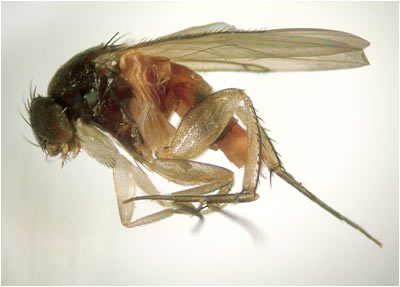 Fig. 10: The scuttle fly Phalacrotophora bruesiana. Photo
Fig. 10: The scuttle fly Phalacrotophora bruesiana. Photo 